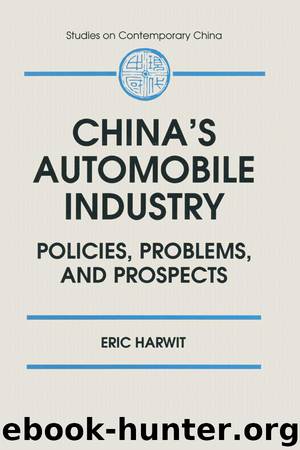China's Automobile Industry: Policies, Problems and Prospects: Policies, Problems and Prospects (Studies on Contemporary China) by Harwit Eric

Author:Harwit, Eric [Harwit, Eric]
Language: eng
Format: azw3
ISBN: 9781315286792
Publisher: Taylor and Francis
Published: 2016-09-15T16:00:00+00:00
The Shanghai Municipal Role
For influencing central government policy, SVW had, as mentioned, two natural allies in its partners, the Bank of China and the CNAIC. Shanghai Mayor Zhu Rongji, however, also used his influence, based on his previous posting in Beijing, to aid SVW. On occasion, for example, the central government’s allocation of steel to the venture was insufficient. According to SVW sources, Zhu was key to increasing the company’s steel quota to satisfy its needs. Such action obviated the need to turn to black market sources, virtually the only recourse when central supplies were too low.
As SVW moved to absorb the remaining space of the Shanghai Car Plant, final permission for the acquisition depended on State Council and CNAIC approval. Chinese sources asserted, however, that Mayor Zhu’s opinion could at the time overrule that of the CNAIC, and that it would also hold great weight in the State Council. Zhu apparently expressed support for the merger as he left his mayor’s post in April 1991, and the consolidation began in June of that year.
Of course, most local political action related to SVW was directed at solving problems on a smaller scale. The Municipal Automotive Small Group took the lead in coordinating the city’s vehicle production policy. Ceremonially led by Zhu, the group in late 1990 included Vice Mayor Huang Ju, who succeeded Zhu as mayor in 1991. Huang, therefore, had some expertise and interest in the industry, and was then likely to extend this concern to his tenure as mayor.
The rest of the small group in 1990 consisted of representatives from the municipal planning, economic, international trade, and construction commissions, and the SAIC leader, Lu Ji’an. Each of the municipal bodies played a role in SVW’s development: the international trade commission helped regulate the company’s foreign exchange, and the economic and planning commissions charted the long-term localization process.
Second only to Zhu Rongji in securing city governmental support for SVW was SAIC head Lu Ji’an, who also had held the post of SVW board chairman from 1987. Lu had been a deputy economic commission chief in Shanghai since the early 1980s, and had simultaneously held the top SAIC position. With national moves to separate government and industry, Lu relinquished his commission post in 1989. Chinese sources, however, note that his power to influence municipal planning officials remained strong. Lu could, for example, help ensure a reliable municipal supply of electricity and water for the automotive plant by using his connections in the Shanghai government. He maintained his leading role at SVW into 1993.
Under the various commissions came two bodies specifically designed signed to aid the SVW project. The Shanghai Localization Office was to consult with venture managers on ways to speed the localization process. A “Shanghai Santana Commonwealth” included local research institutes and universities, and was designed to coordinate city-wide efforts to improve production of the German-designed vehicle. Of all the ventures examined in this study, SVW was the only one receiving advice from such an institutionalized forum.
In general, Shanghai seemed to take great pride in the progress of the German auto company.
Download
This site does not store any files on its server. We only index and link to content provided by other sites. Please contact the content providers to delete copyright contents if any and email us, we'll remove relevant links or contents immediately.
The Brazilian Economy since the Great Financial Crisis of 20072008 by Philip Arestis Carolina Troncoso Baltar & Daniela Magalhães Prates(117874)
International Integration of the Brazilian Economy by Elias C. Grivoyannis(87732)
The Art of Coaching by Elena Aguilar(52870)
Flexible Working by Dale Gemma;(23239)
How to Stop Living Paycheck to Paycheck by Avery Breyer(19616)
The Acquirer's Multiple: How the Billionaire Contrarians of Deep Value Beat the Market by Tobias Carlisle(12206)
Thinking, Fast and Slow by Kahneman Daniel(12012)
The Radium Girls by Kate Moore(11891)
The Art of Thinking Clearly by Rolf Dobelli(10167)
Hit Refresh by Satya Nadella(9011)
The Compound Effect by Darren Hardy(8769)
Tools of Titans by Timothy Ferriss(8178)
Atomic Habits: Tiny Changes, Remarkable Results by James Clear(8154)
Turbulence by E. J. Noyes(7913)
A Court of Wings and Ruin by Sarah J. Maas(7604)
Change Your Questions, Change Your Life by Marilee Adams(7597)
Nudge - Improving Decisions about Health, Wealth, and Happiness by Thaler Sunstein(7518)
How to Be a Bawse: A Guide to Conquering Life by Lilly Singh(7359)
Win Bigly by Scott Adams(7065)
